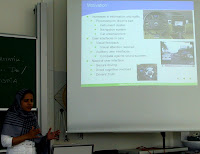For the second time we ran this year a workshop on automobile user interfaces and interactive applications in the car at the German HCI conference: http://automotive.ubisys.org/
In the first session we discussed the use of tactile output and haptics in automotive user interfaces. It appears that there is significant interest in this area at the moment. In particular using haptics as an additional modality creates a lot of opportunities for new interfaces. We had a short discussion about two directions in haptic output: naturalistic haptic output (e.g. line assist that feels like going over the side of the road) vs. generic haptic output (e.g. giving a vibration cue when to turn).
I think the first domain could make an interesting project – how does it naturally feel to drive too fast, to turn the wrong way, to be too close to the car in front of you, etc…
In a further session we discussed framework and concepts for in-car user interfaces. The discussion on the use of context with the interface was very diverse. Some people argued it should be only used in non-critical/optional parts of the UI (e.g. entertainment) as one is not 100% sure if the recognized context is right. Others argue that context may provide a central advantage, especially in safety critical systems, as it gives the opportunity to react faster.
In the end it comes always down to the question: to what extent do we want to have the human in the loop… But looking at Wolfgang’s overview slide it is impressive how much functionality depends already now on context…
In the third session we discussed tools and methods for developing and evaluating user interfaces in the car context. Dagmar presented our first version of CARS (a simple driving simulator for evaluation of UIs) and discussed findings from initial studies [1]. The simulator is based on the JMonkey Game engine and available open source on our website [2].
There were several interesting ideas on what topics are really hot in automotive UIs, ranging from interfaces for information gather in Car-2-Car / Car-2-Envrionment communication to micro-entertainment while driving.
[1] Dagmar Kern, Marco Müller, Stefan Schneegaß, Lukasz Wolejko-Wolejszo, Albrecht Schmidt. CARS – Configurable Automotive Research Simulator. Automotive User Interfaces and Interactive Applications – AUIIA 08. Workshop at Mensch und Computer 2008 Lübeck 2008
[2] https://www.pcuie.uni-due.de/projectwiki/index.php/CARS
PS: In a taxi in Amsterdam the driver had a DVD running while driving – and I am sure this is not a form of entertainment that works well (it is neither fun to watch, nor is it save or legal).



